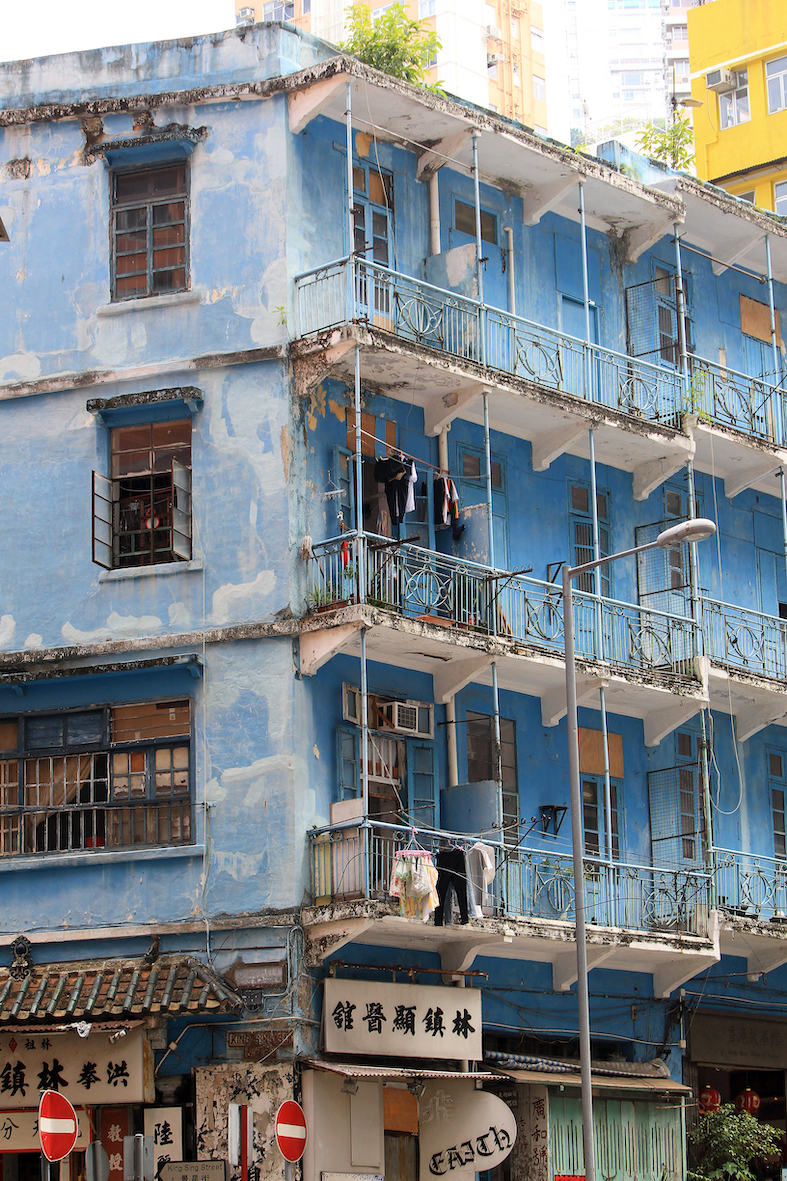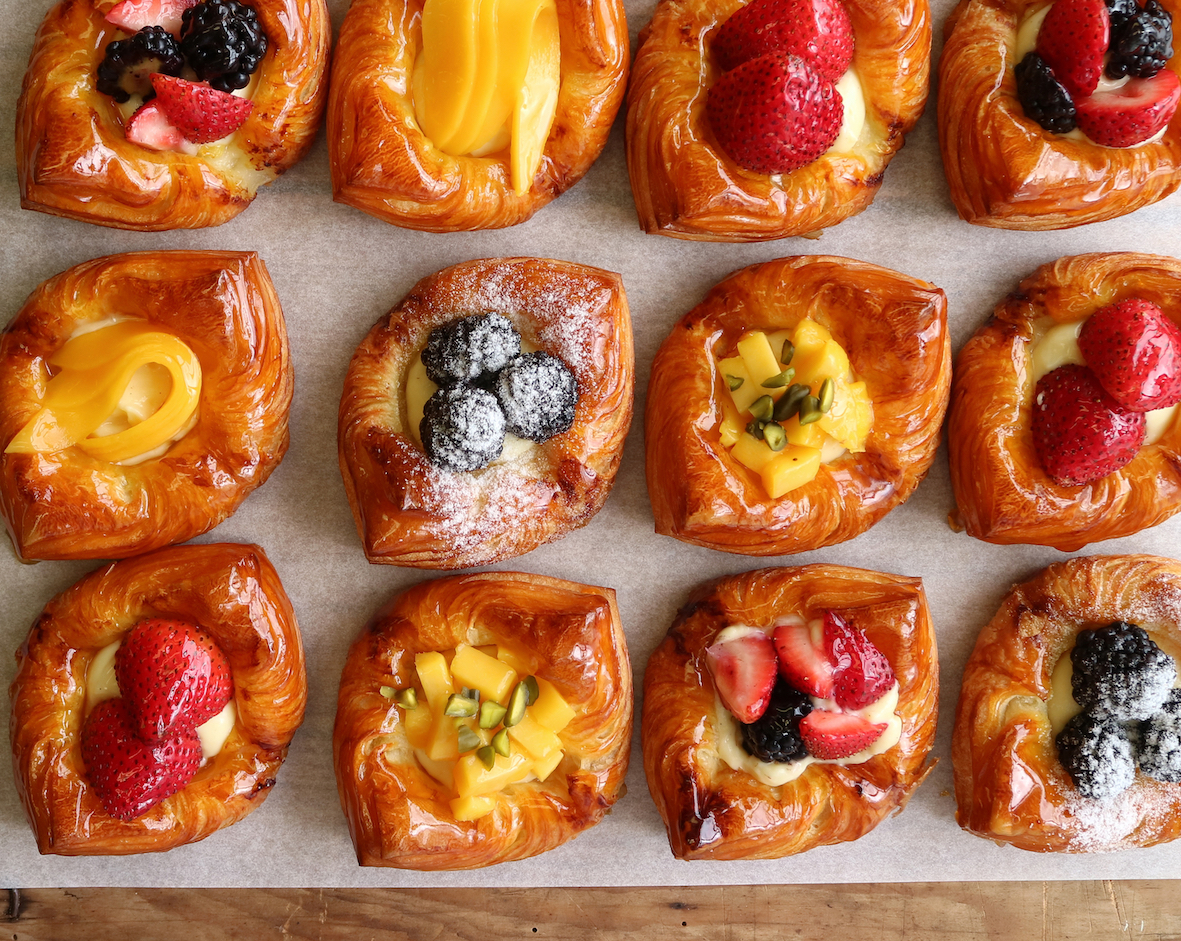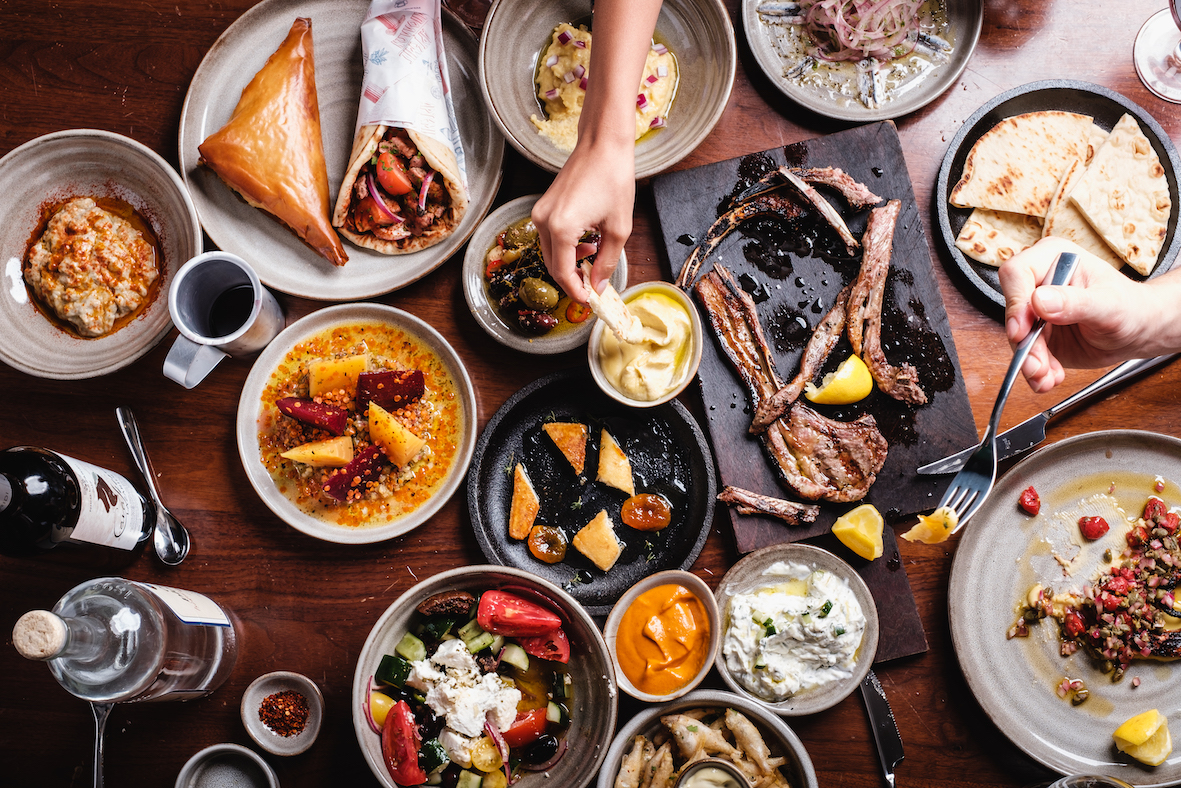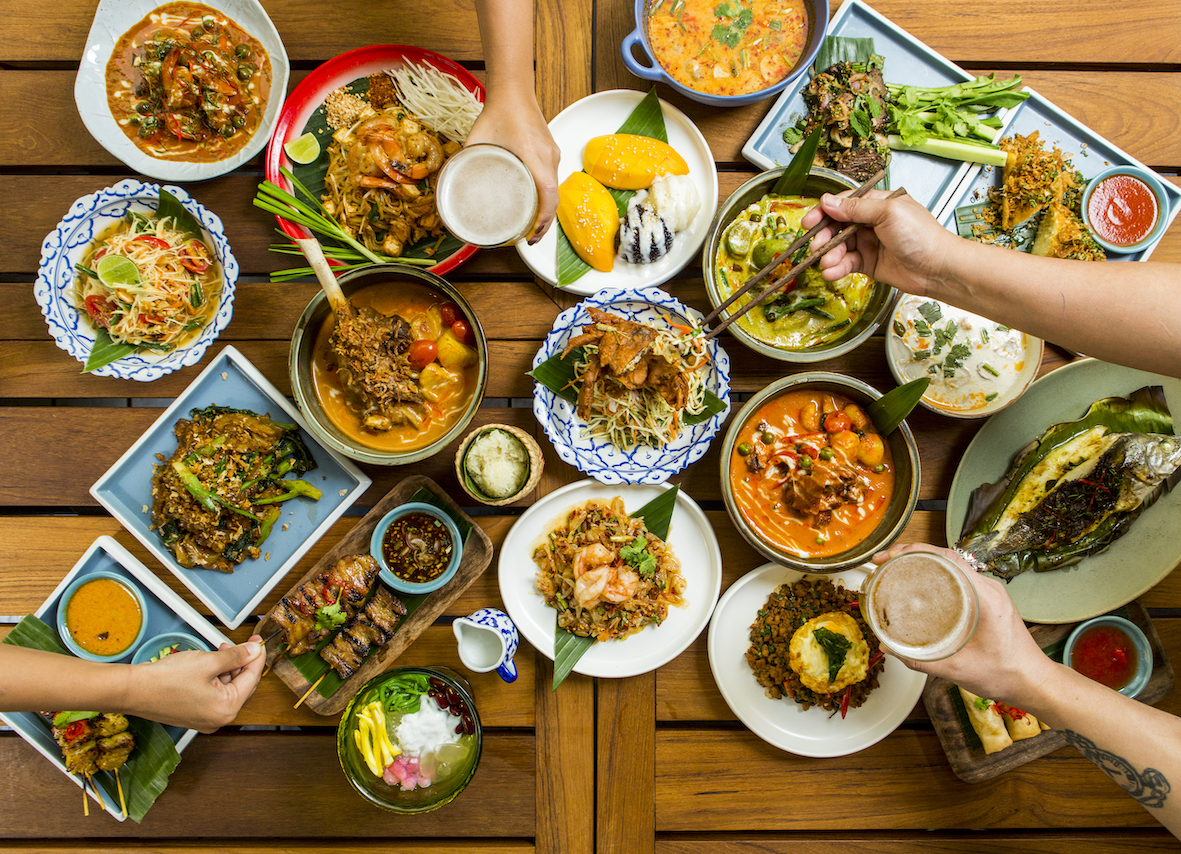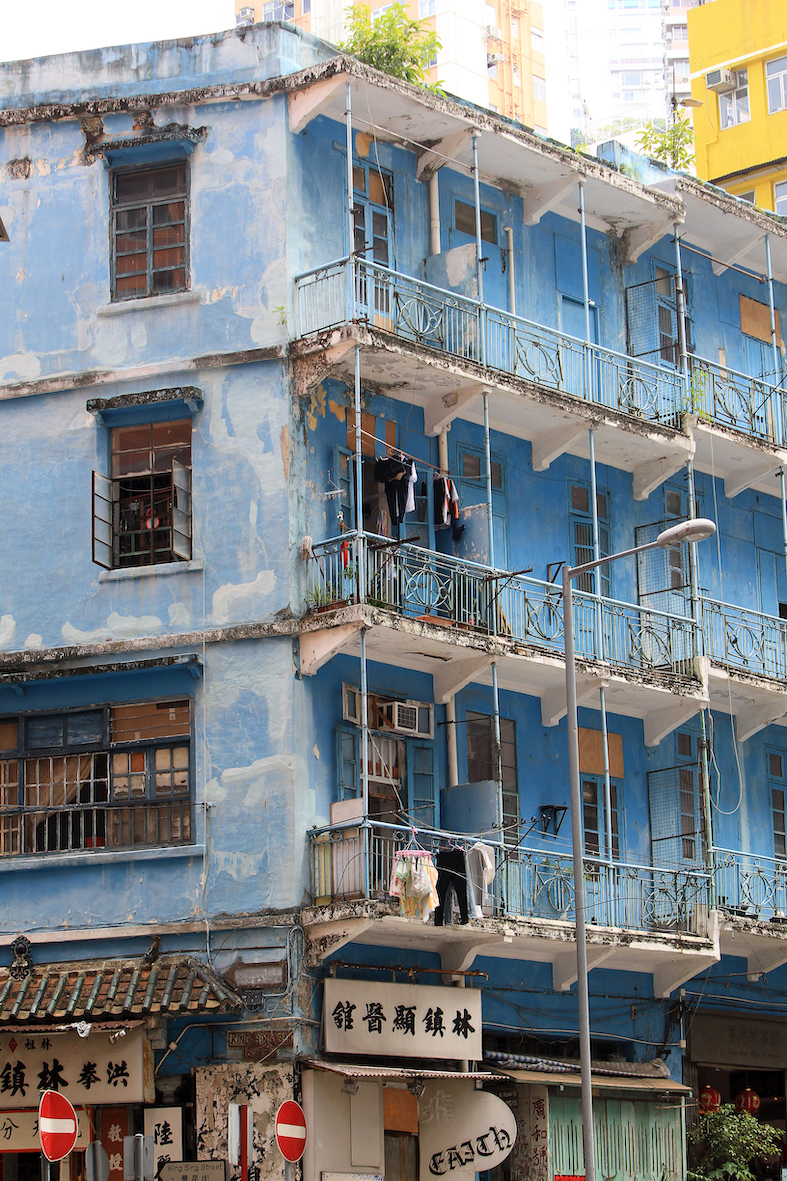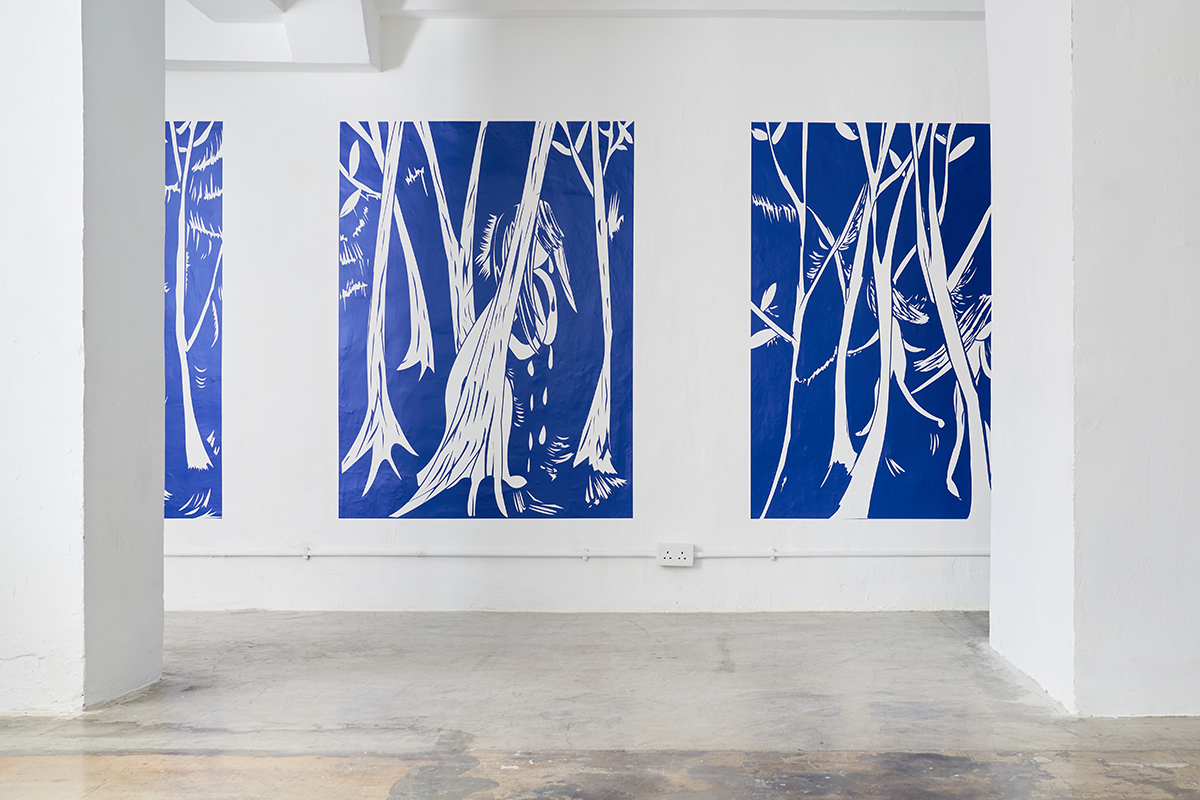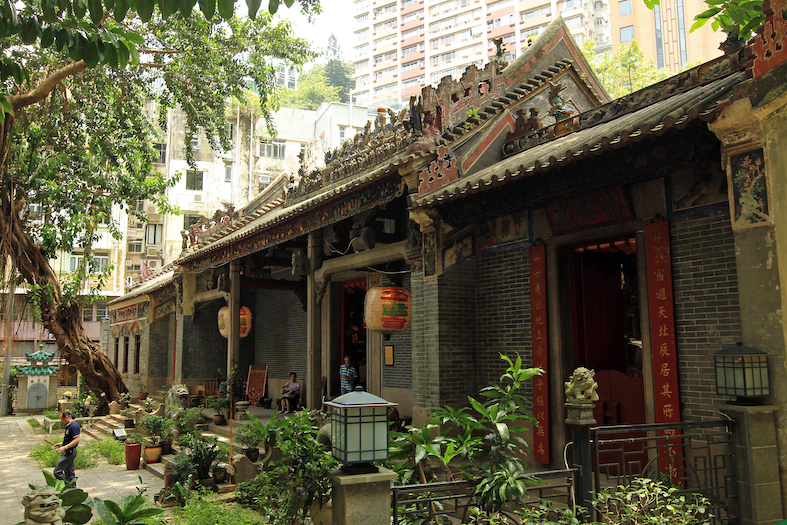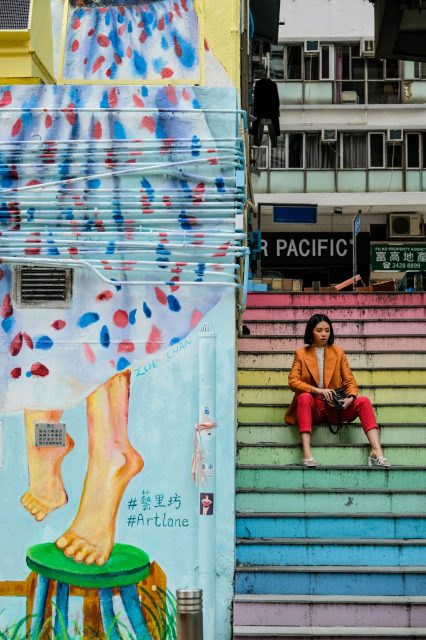On Wan Chai’s busy streets, pedestrians walk quickly and with purpose, darting into the market stalls that are a cacophony of sound — vendors loudly touting their wares and taxis honking. Signs jut out from buildings in seemingly haphazard ways, and many of the colourful tenement buildings (some of the first to have been developed in the city) have begun to crumble. A series of urban regeneration programs have seen a host of new restaurants, bars, concept stores and contemporary art galleries arrive, but pockets of old Hong Kong remain – a quiet temple, Stone Nullah Lane’s iconic blue tenement building, and streets adorned with the larger-than-life roots of trees – creating a diverse neighbourhood.
EAT
Samsen
With short stalls, two-person tables and rickety-shuttered windows that open onto Stone Nullah Lane, Samsen transports diners to street-food dining in northern Thailand. Named after the area in Bangkok where the Chinese traded with the Thais, it is the first outpost from Chachawan alumnus — chef Adam Cliff and partner Bella Kong — who quickly found success after opening Samsen in 2016. Bold Thai flavours, traditional cooking and vintage shophouse-decor keep the regulars coming back — the same is true of the tender wagyu beef boat noodles and vibrant green mango salad with tiger prawns and crispy shallots.
68 Stone Nullah Ln, Wan Chai; instagram.com/samsenhk
Pici
Neighbourhood staple Pici is beloved for its fresh, hand-made pasta served in a casual space at St Francis Yard — a quiet enclave of Wan Chai, with a lively food, drink, art and fashion scene. Take a seat at one of their indoor-outdoor tables and order a plate of cacio e pepe pici – a thick, hand-rolled pasta that originates in the Tuscan town of Siena, from which the restaurant gets its name. Pici’s truffle tagliolini and signature carbonara — a ravioli filled with a runny yolk — are delicious too. Starters are a casual affair with bread and arancini balls served in paper bags, which, added to the affordable prices, make this an excellent option.
GF, 16 St Francis Yard, Wan Chai; pici.hk
Francis
Herbs and spices ranging from cumin to coriander seeds, turmeric, sumac, mint and parsley, are central to Middle Eastern cuisine and are celebrated at this neighbourhood joint on Star Street. It’s menu of Israeli dishes draws on the head chef Asher Goldstein’s memories of meze and hearty grilled plates found on the vibrant streets of Tel Aviv, featuring everything from shakshuka and halloumi with pomegranate to dips of beetroot smoked labneh and hummus. As every great meal should end with something sweet, its knafeh with mozzarella, topped with vanilla ice cream and pistachio, is a must-try.
4 – 6 St. Francis Street, Wan Chai, Hong Kong, francis.com.hk
Bakehouse
There’s always queues around the block at this Wan Chai favourite, a huge industrial-style bakehouse founded by Swiss pastry chef Grégoire Michaud. With more than 25 years experience, leading kitchens at hotels that include the Four Seasons in Hong Kong, he’s mastered flaky croissants and tarts (the standout sourdough egg tart is a must). If you’re after something savoury, the a la carte menu lists creamy roasted mushrooms on homemade sourdough, an avocado benedict, and a croque madame with gruyere and a pommery mornay sauce on a pain de mie, best enjoyed at a table by the window, watching the world go by.
14 Tai Wong St E, Wan Chai; bakehouse.hk
Mr. Brown
This BBQ joint from the team behind Francis offers up an array of grilled meats and smokehouse favourites. It’s name Mr Brown might come from the Southern slang referring to the dark, smoky outside part of barbecued pork shoulder, but it’s decor is much more east coast, with dark lighting and deep wooden tables more at home in New York. Subscribing to the seasonal-small-plates zeitgeist, it’s offerings include things like whipped mackerel, miso grilled aubergine, and artichoke and ricotta to go with their briskets, steaks and skewers.
9 Ship St, Wan Chai; mrbrownhk.com
Artemis and Apollo
Named after Zeus and Leto’s twin girls Artemis and Apollo, this traditional taverna on Moon Street celebrates Greek culture in more ways than one. Start with a glass (jug or bottle — it comes as both) of ouzo, a dry anise-flavoured aperitif that is widely consumed in Greece and Cyprus. Next, it’s food that is unfussy and family-style — meat and fish that’s charred, and olives and dips that are drowned in oil. The saganaki platanos is seared in a cast-iron skillet, smothered in spiced honey with candied apricots, while a filo pastry spanakopita comes light and crispy. Bottles of wine, tins of oil and jars of pickled vegetables are stacked on the walls, complementing the restaurant’s green booths. There’s a long sharing table in the ‘Kipos,’ a garden-like setting that can be hired out for private events.
G/F, 9-11 Moon Street, Wan Chai; artemisandapollo.com
1963 Tree
Tucked away on the second floor of Chung Wui Mansion, a yellow building on Stone Nullah Lane that’s impossible to miss, Taiwanese restaurant 1963 Tree is a nostalgic journey back in time. It’s often hired out for film and photo shoots because of it’s floral wallpapers, patterned table-cloths, old mailboxes and eclectic crockery. But besides the vintage furnishings are home-style dishes that feature all the classics: Taiwan’s famous three-cups chicken; fried prawns with pineapple; and betel tree flowers with carrots and mushrooms.
2/F, Chung Wui Mansion , 110 Wan Chai Road, Wan Chai
Le Garcon Saigon
Pale blue washed walls, haphazardly hung black and white pictures of Vietnamese scenes, and Parisian style bistro chairs firmly place this restaurant in colonial-era Saigon. Take a pew at one of the tables outside that are perfect for long weekend lunches spent enjoying woodfired Vietenamese food, and sipping free-flow white wine. Dishes are colourful: the DIY rice paper rolls come with piles of pickled carrot, cucumber, bright Vietnamese herbs and vermicelli noodles; a barramundi is served in a banana leaf with chilli; while charred grill dishes such as butter corn and crispy aubergine are seriously moreish. Le Petit Saigon is next door, selling banh mi (Vietnamese sandwiches) to go.
12-18 Wing Fung Street, Wan Chai; legarconsaigon.com
Roots
This blue-fronted restaurant on Sun Street serves up Cantonese-inspired French fare. It’s an unusual combination from banker-turned-chef Stephanie Wong, but it works, drawing on classic Cantonese dishes that are elevated by her French culinary training. Her cooking was first debuted at PMQ’s restaurant incubator Taste Kitchen in 2018, with this bricks-and-mortar eatery arriving 10 months later. Rough grey concrete walls highlight local art, but it’s the impeccable dishes that keep people coming back: comte and goat cheese madeleines; a beef tartare yu kwan yick-style; and a French roasted spring chicken with glutinous rice stuffing.
7 Sun St, Wan Chai; rootseatery.com
Ruam
Named after the Thai word for ‘to gather,’ this casual restaurant encourages just that, with its large outdoor terrace, round tables and long sharing benches. It’s an authentic eatery that sticks to much-loved classics: tom yum soup; charred satay skewers; and a creamy coconut-based prawn curry with kaffir and peanuts. For dessert there’s a mango and sticky rice that’s sweet-and-salty like it should be. This is an unpretentious spot hidden behind Ship Street that serves simple, aromatic dishes with just enough spice and good drinks.
1/F, J Senses, 60 Johnston Road, Ship St, Wan Chai; 3160 8535; ruam-thai.com
Osteria Marzia
Inspired by the cooking of Italy’s coastal towns, from Campania, Amalfi and Puglia to southern Sicily, Osteria Marzia celebrates the flavours of the seaside. Fish is the restaurant’s strength, from the charred slices of crusty sourdough served up with butter and anchovies to start. There’s a standout hokkaido scallop tartare, a delicious chitarra served with generous chunks of Boston lobster and cherry tomato, plus a market fish that can be ordered either grilled, in puttanesca, in brown butter caper sauce, salt-baked or acqua pazza. The seaside theme continues throughout the spacious, bright and airy dining room with nautical lamps and sleek blue leather banquettes.
Osteria Marzia, G/F, The Fleming, 41 Fleming Road, Wan Chai; osteriamarzia.com.hk
DRINK
The Pawn
Housed in one of the most iconic buildings in Wan Chai, a former pawn shop that dates back to 1888, The Pawn is both a restaurant and bar occupying three floors of the building. It’s Botanicals Bar has fantastic outdoor seating — comfortable sofas, tiled floors, and plenty of potted plants — and looks out onto the tramline below, maximising the buzz of its surrounding area. DJs spin in the main room each Friday and Saturday, with a Havana-inspired Buena Vista Social Club night every month.
62 Johnston Road Wan Chai; thepawn.com.hk
Tai Lung Fung
This trendy neighbourhood bar, named after a famous 1960s Cantonese opera troupe ‘Big Dragon Phoenix,’ on a quiet street off Stone Nullah Lane is full of originality. A neon sign shows off its whereabouts, while plastic light fixtures, antique memorabilia, framed advertisements and newspaper clippings adorn the battered walls. The drinks are simple and unpretentious — there are a couple of craft beers on tap and a few classic cocktails written out on menus that look like old newspapers — but it’s the playful atmosphere that keeps locals happy.
The Archive, 5-9 Hing Wan St, Wan Chai; facebook.com/大龍鳳-TAI-LUNG-FUNG
Basao Tea
This zen tea shop is a welcome oasis in the middle of bustling Wan Chai. Minimalist interiors and stylish cups serve only to highlight Basao Tea’s offerings of single-origin sourced Asian teas, cleanly grown from around the region. It specialises in tea from China, Taiwan, Japan, India, Sri Lanka and Nepal, that are all ethically sourced —Basao controls the whole process from leaf to cup and works closely with local farmers. The in-house selection of black and green teas is extensive, but Basao also sell summer cold brew kits that come complete with a bottle, an assorted Gongfu Teabag pack, and recipe booklet.
17號 Moon St, Wan Chai; basaotea.com
Blend & Grind
Local haunt Blend & Grind is a tiny open-fronted coffee shop on the corner of Sun Street, with high stalls in the street. It serves good, strong, ethically-sourced brews by Reback Coffee, freshly squeezed organic juices and vibrant smoothies amid a flurry of lush botanicals. It’s the perfect spot to settle into the Sunday papers while grabbing something wholesome for brunch – there’s acai bowls, poached eggs on zucchini fritters, a superfood salad or opt for the signature breakfast board.
1 Sun Street, Wan Chai; instagram.com/blendgrindhk
APT Coffee
Another Moon Street staple, this bamboo-fronted coffee shop is a minimalist delight. Not only is the space crisp and white-washed but it’s menu is also streamlined. It offers little beside coffee and toast, titled ‘toast tailoring’ and ‘coffee tailoring.’ Diners can choose the number of toppings they want on their toast, the type of bread (either sourdough or fig and walnut), and a type of spread. The same is true of the coffee, which includes a choice of a nutty or fruity blend, and various milk, temperature and foam volume options.
2-12 Moon Street, Wanchai; apt-coffee.com
SHOP
Kapok
This is Kapok’s flagship store, one of six concept stores dotted around Hong Kong that was founded by French entrepreneur Arnault Castel, who lives around the corner in the Blue House. At its Sun Street location, find fashion and home products in a retail space adorned with plywood, and holistic lifestyle products that include home decor and Elixirs, clean beauty, and other organic and ethical gifts.
8 Sun Street, Wan Chai, Hong Kong; ka-pok.com
Maison XXII
European-inspired florist, home and lifestyle store Maison XXII is set in a three-story space to reflect the spirit of Les Baux-de-Provence in France. Along with candles, flowers and fine chocolates, it offers lighting, furniture by Danish homeware label Frama, and wireless speakers from aFunk, along with books, magazines and stationery. The shop also hosts various workshops from floristry to confectionary.
15 St. Francis Street, Wan Chai, Hong Kong; shop.maisonxxii.com
SEE
Blue House
Photo: Franke Tsang/South China Morning Post at Getty Images
Impossible to ignore, this electric blue, four-storey building on Stone Nullah Lane was built in 1922, and was once an overcrowded tenement. It’s one of the few remaining examples of a tong lau – a type of 19th century residential building notable for its balconies, popular in Hong Kong and south China. The Blue House gained its name because it was coloured with leftover paint from the Water Supplies Department. In 2007, the building was renovated but the historical features were preserved — tiled floors, iron railings and steep timber staircases — and a living museum was created on the ground floor called the Hong Kong House of Stories, which now hosts events and exhibitions.
Blue House, 72 Stone Nullah Lane, Wan Chai, Hong Kong; vivabluehouse.hk
Taka Ishii Gallery
Taka Ishii Gallery in Hong Kong serves as an international platform for presenting the work of emerging Japanese artists and contemporary masters, including Nobuyoshi Araki — known by the mononym Arākī for his photography work that blends eroticism and bondage in a fine art context. He’s now printed more than 500 books, but the art gallery has some of his earliest. While the gallery aesthetic is rooted in the photographic, Take Ishii also celebrates artists of all kinds of mediums.
Bo Fung Mansion, Shop 4A & 4B UG/F, No. 1 St Francis Yard, Wan Chai; takaishiigallery.com
Pak Tai Temple
Photo: Franke Tsang/South China Morning Post at Getty Images
Home to a 400-year-old Ming Dynasty Pak Tai statue that stands at three metres tall, as well as a number of other deities, this Grade I-listed temple sits at the top of a quiet street in Wan Chai, flanked by centuries-old trees and a small pagoda where retirees spend their days. It was built in 1863 for the residents of the area to worship Pak Tai, the deity of water, which makes sense once you know that up until 150 years ago Wan Chai (which means tiny bay) sat on the shoreline.
2 Lung On St, Wan Chai; discoverhongkong.com
Editor
Emma RussellCredit
Lead image: Franke Tsang/South China Morning Post at Getty Images